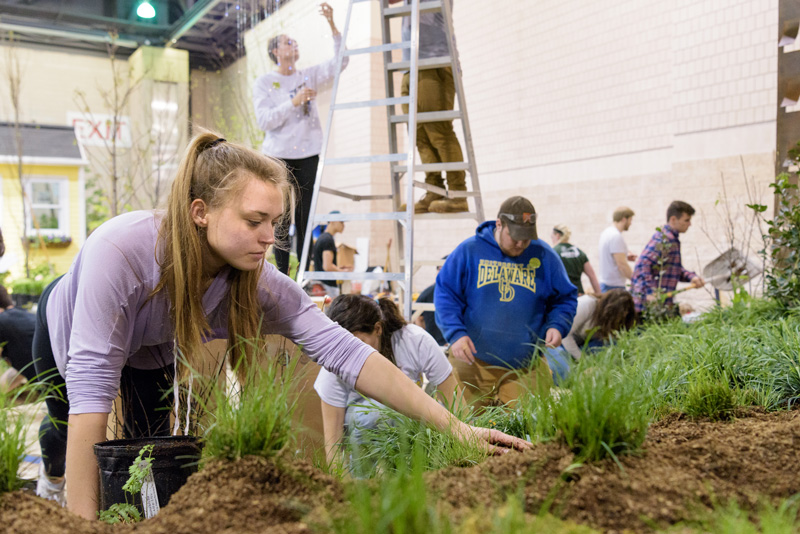


UD at the 2018 Philadelphia Flower Show
Photo by Evan Krape March 02, 2018
Students focus on vernal pools for show exhibit
Every spring, vernal pools formed by rain and runoff appear throughout the state of Delaware, providing essential habitats and breeding grounds for species such as frogs and insects—who can take advantage of the areas because of their lack of predators—and a variety of shrub and herbaceous plant communities.
While these areas provide ecosystem services for plants and wildlife, vernal pools are currently not a protected ecosystem in the state of Delaware.
To help bring awareness to these areas, University of Delaware students decided to highlight vernal pools as part of their “Delmarva Bays Spring to Life” exhibit which will be on display Saturday, March 3 through Sunday, March 11 as part of the 2018 Philadelphia Flower Show at the Pennsylvania Convention Center. This year’s overall show theme is Wonders of Water.
The idea of using vernal pools for the exhibit came from Olivia Kirkpatrick, a senior majoring in landscape architecture, who is a student in Jules Bruck’s Design Process Practicum class.
Members of that class help with the flower show build for the first part of the class and then spend the second half of the class developing ideas that eventually became the design for next year’s flower show.
“Olivia really liked the ephemeral nature of water, that rain showers come and go, ice melts, there’s mist and then it’s gone,” said Bruck, an associate professor and director of landscape architecture in the College of Agriculture and Natural Resources. “She was playing with the words surrounding that ephemeral nature of water and it all pointed to this idea of the vernal pools. Our exhibit is about an ecosystem that’s like a small wetland and because of the size of it, it’s not a protected ecosystem but it should be because there’s these amazing creatures that use the vernal pools as their breeding ground and habitat that are worthy of protecting.”
Bruck said that the class had Jim White from the Delaware Nature Society come in and speak about the ecosystems which have wonderful sounding tree frogs such as spring peepers—an aspect which will be brought to life at the exhibit through the use of audio.
“What’s special about vernal pools is they don’t accommodate breeding fish,” Bruck said. “If they had fish in the ecosystem, the fish would be the top predator. Without the fish, all these other things can thrive and birds use it as a stop-over so it’s a really special little, typically woodland ecosystem. There could be a vernal pool near you and you don’t even know about it. What we are interested in doing is promoting the idea that these are special ecosystems and they should be protected and preserved.”
Maggie Heffernan, a senior majoring in landscape architecture and president of the Design and Articulture (DART) club who has been involved with the flower show builds for the past three years, said that this year’s exhibit is a bit more abstract than in previous years.
“The exhibit is not just showing you a vernal pool and what it would look like in nature, but bringing the feeling of it to life,” said Heffernan. “We’re having ephemeral sculptures, flowers that Zach Stark, [a blacksmith working with iron for the show] is making for us and then we’ll have these trees that are made out of iron too so more representations. We still have plants that are native to those areas and everything but these aspects will give it an extra feeling.”
Heffernan, the president of the student club involved in the exhibit build, said that she didn’t know too much about vernal pools before the build but has learned a lot over the course of the project’s construction.
“One of the things that we’re trying to push is the importance of keeping the vernal pools alive because they do provide so much habitat for species that would otherwise not be there,” said Heffernan.
Interpretive Dance
New this year, the UD exhibit will incorporate a more interactive feature as well. Every day of the flower show, students will perform a dance embodying the Delmarva Bays in movement, the result of a four-week course over winter session co-taught by Kimberly Schroeder, director of UD’s dance minor, and Delaware Sea Grant marine advisory service specialist Jame McCray, an interdisciplinary ecologist by training with a passion for dance and its use to reach people with environmental information.
In addition to working with the students on the dance and the scientific information it conveys, McCray is contributing to interpretive signs and will be evaluating the exhibit’s impact on the audience at the flower show by studying things like where people spend the most time, what messages they take away from the exhibit, and how it affects them. You can read more about McCray’s work on the exhibit and her approach to integrating arts and science education on Delaware Sea Grant’s website.
Contact Us
Have a UDaily story idea?
Contact us at ocm@udel.edu
Members of the press
Contact us at 302-831-NEWS or visit the Media Relations website

